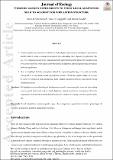Files in this item
Common garden experiments to study local adaptation need to account for population structure
Item metadata
| dc.contributor.author | de Villemereuil, Pierre | |
| dc.contributor.author | Gaggiotti, Oscar E. | |
| dc.contributor.author | Goudet, Jérôme | |
| dc.date.accessioned | 2021-11-12T00:43:27Z | |
| dc.date.available | 2021-11-12T00:43:27Z | |
| dc.date.issued | 2020-11-12 | |
| dc.identifier | 270734336 | |
| dc.identifier | b504eafe-bd0d-4802-b257-b3f0735e6b5d | |
| dc.identifier | 000588404900001 | |
| dc.identifier | 85096704879 | |
| dc.identifier.citation | de Villemereuil , P , Gaggiotti , O E & Goudet , J 2020 , ' Common garden experiments to study local adaptation need to account for population structure ' , Journal of Ecology , vol. Early View . https://doi.org/10.1111/1365-2745.13528 | en |
| dc.identifier.issn | 0022-0477 | |
| dc.identifier.other | RIS: urn:FFF76A479978718363064A75F71F8822 | |
| dc.identifier.uri | https://hdl.handle.net/10023/24327 | |
| dc.description.abstract | 1. Common garden experiments are precious to study adaptive phenomenon and adaptive potential, in that they allow to study local adaptation without the confounding effect of phenotypic plasticity. The QST − FST comparison framework, comparing genetic differentiation at the phenotypic and molecular level, is the usual way to test and measure whether local adaptation influences phenotypic divergence between populations. 2. Here, we highlight that the assumptions behind the expected equality QST = FST under neutrality correspond to a very simple model of population genetics. While the equality might, on average, be robust to violation of such assumptions, more complex population structure can generate strong evolutionary noise. 3. Synthesis. We highlight recent methodological developments aimed at overcoming this issue and at providing a more general framework to detect local adaptation, using less restrictive assumptions. We invite empiricists to look into these methods and theorists to continue developing even more general methods. | |
| dc.format.extent | 282663 | |
| dc.language.iso | eng | |
| dc.relation.ispartof | Journal of Ecology | en |
| dc.subject | Common garden | en |
| dc.subject | Local adaptation | en |
| dc.subject | Phenotypic divergence | en |
| dc.subject | Population genetics | en |
| dc.subject | Population structure | en |
| dc.subject | QST − FST comparison | en |
| dc.subject | Quantitative genetics | en |
| dc.subject | QA Mathematics | en |
| dc.subject | QH301 Biology | en |
| dc.subject | QH426 Genetics | en |
| dc.subject.lcc | QA | en |
| dc.subject.lcc | QH301 | en |
| dc.subject.lcc | QH426 | en |
| dc.title | Common garden experiments to study local adaptation need to account for population structure | en |
| dc.type | Journal item | en |
| dc.contributor.institution | University of St Andrews. School of Biology | en |
| dc.contributor.institution | University of St Andrews. Scottish Oceans Institute | en |
| dc.contributor.institution | University of St Andrews. Marine Alliance for Science & Technology Scotland | en |
| dc.identifier.doi | 10.1111/1365-2745.13528 | |
| dc.description.status | Peer reviewed | en |
| dc.date.embargoedUntil | 2021-11-12 |
This item appears in the following Collection(s)
Items in the St Andrews Research Repository are protected by copyright, with all rights reserved, unless otherwise indicated.

